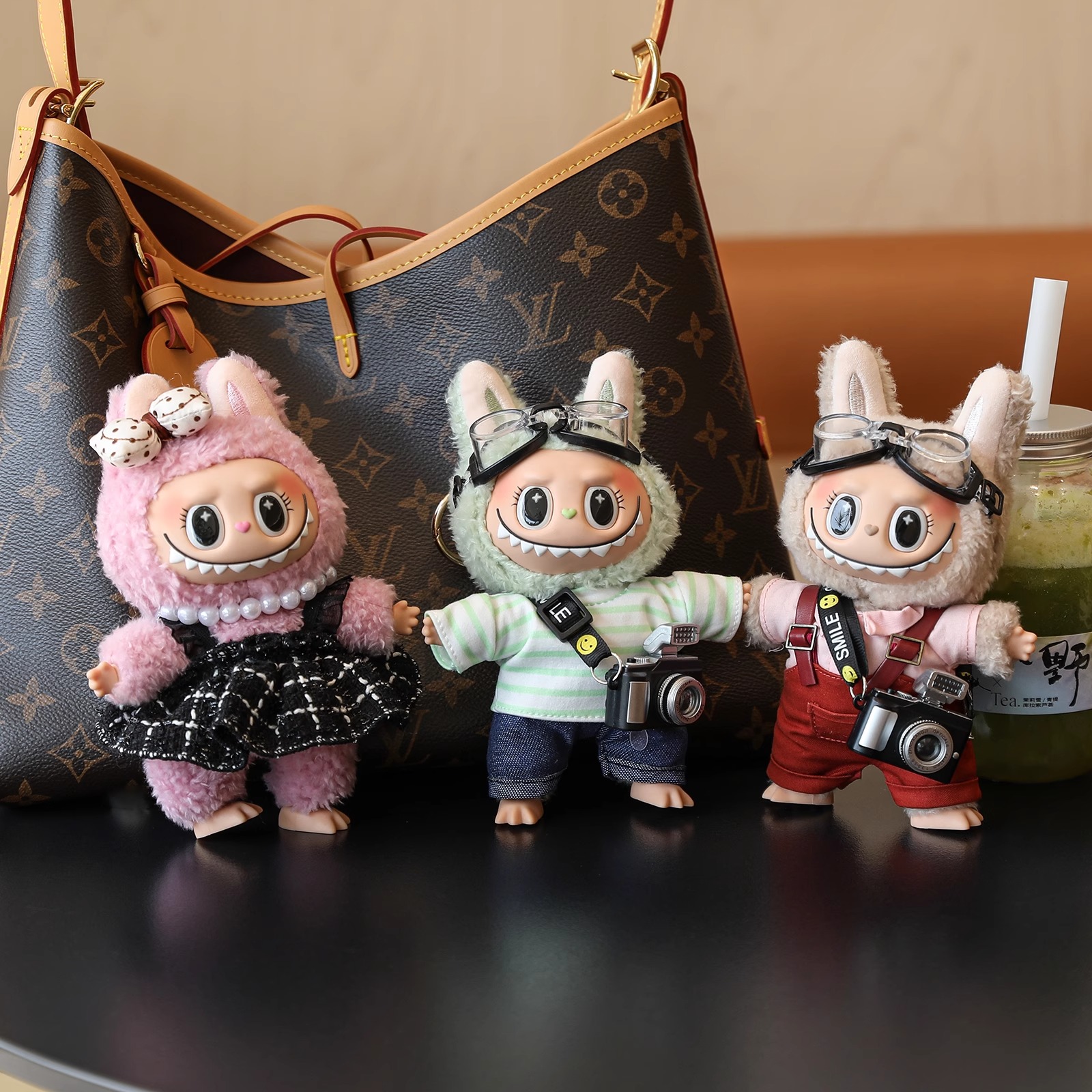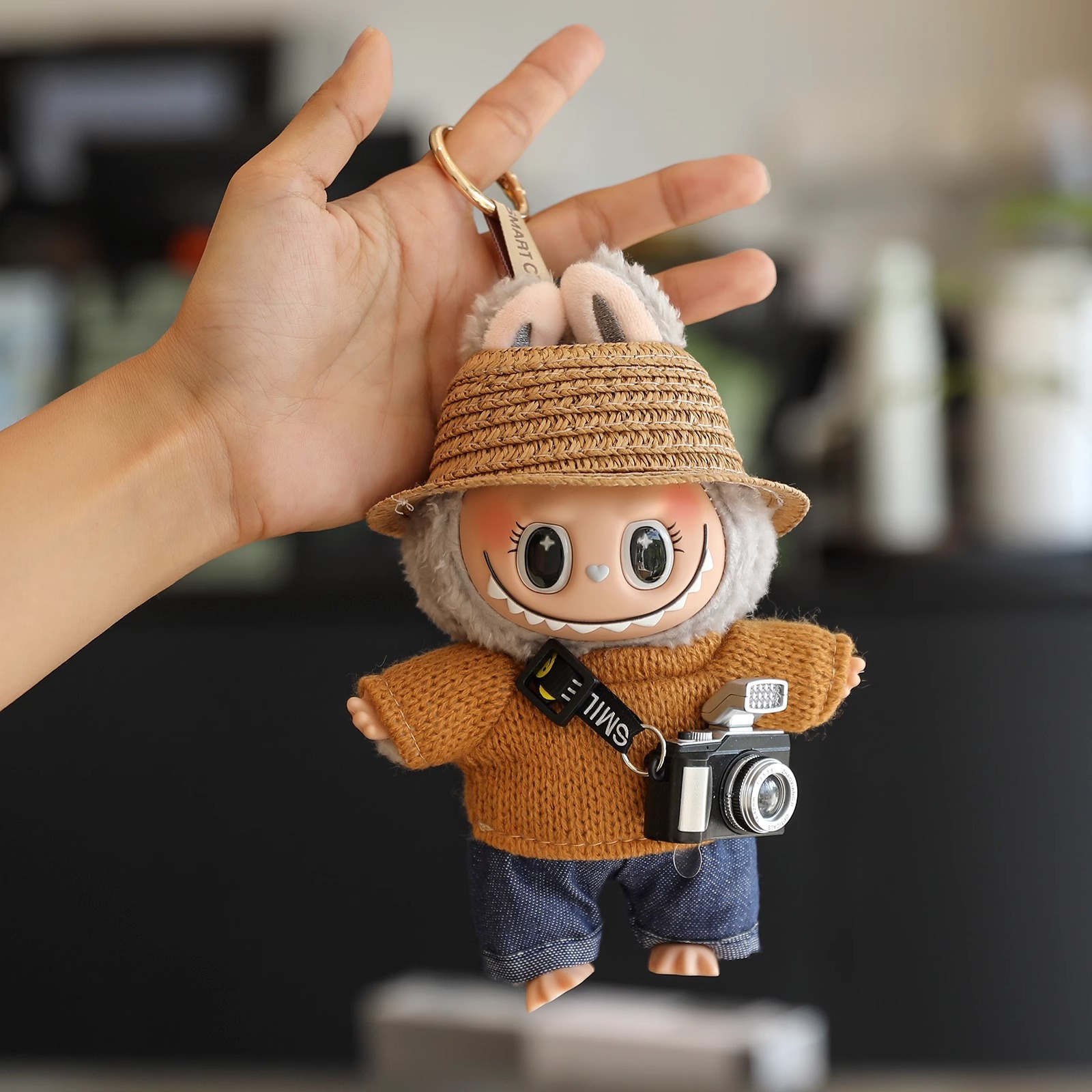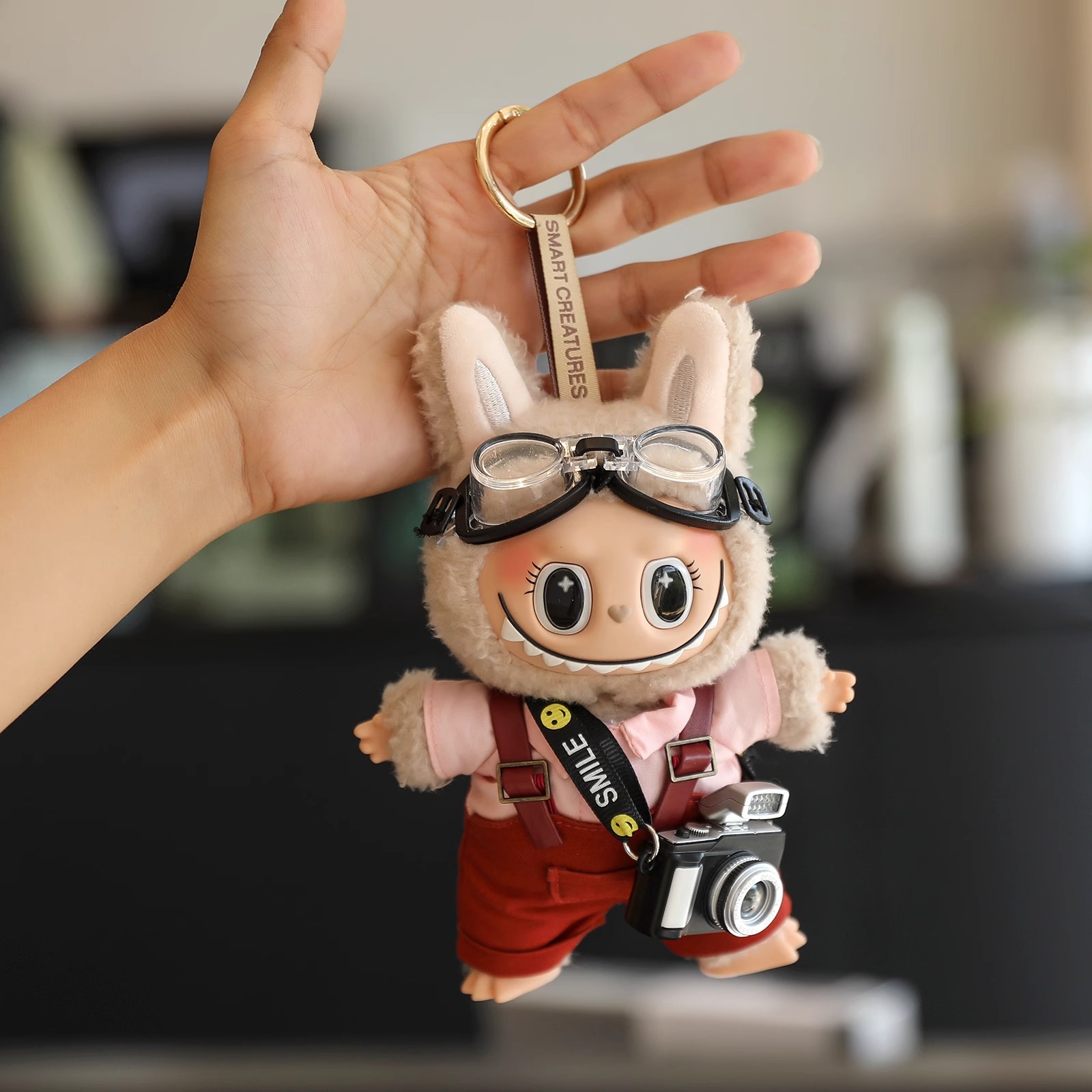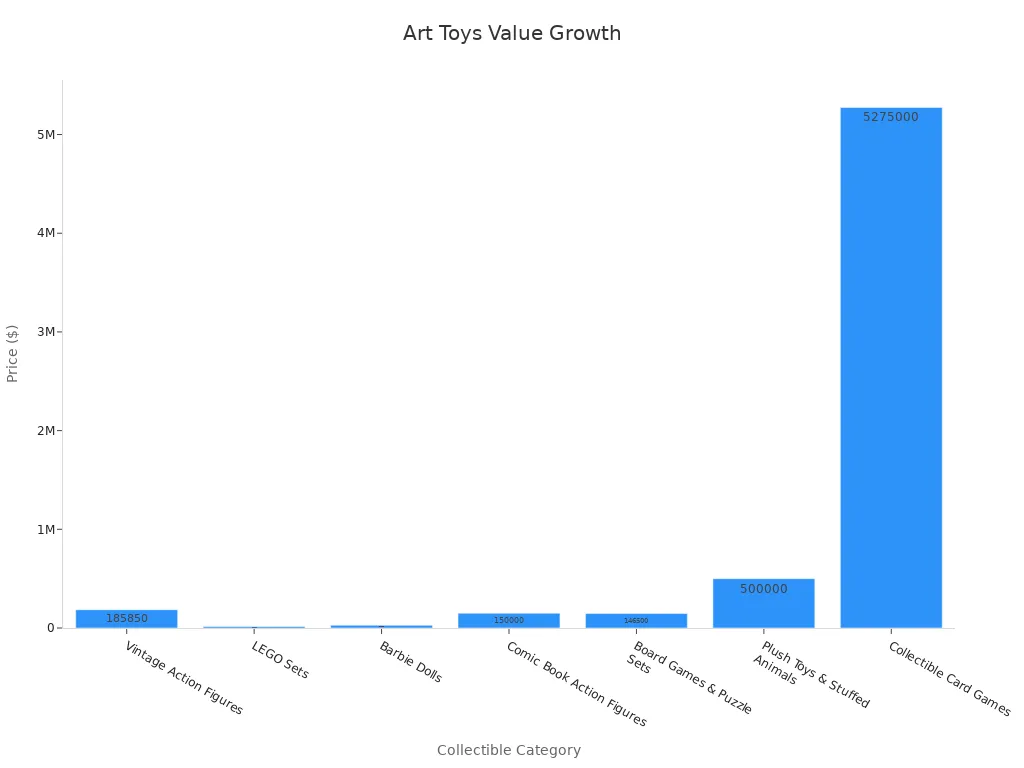What Are Designer Art Toys and Why Are They So Popular

Designer art toys mix creativity, pop culture, and collectibility in special ways. Artists make these collectible figures in small numbers. This makes each one unique. Art lovers and collectors like these toys for their cool designs. They also enjoy the excitement of owning rare items. The worldwide market for art toys was over $8.5 billion in 2023. This shows there is a lot of demand and growth.
Many people like being part of the growing group that celebrates new releases and customization.
Key Takeaways
-
Designer art toys are special figures made by artists. They are made in small amounts. These toys mix creativity and pop culture together.
-
These toys are different because of their cool materials. They come in limited editions. Their artistic designs attract mostly adult collectors.
-
Art toys get more popular because of social media. Artist collaborations help too. Collector groups around the world also help them grow.
-
Limited edition toys are more valuable. They are more fun to collect. Their prices often go up over time.
-
To start a collection, pick toys you enjoy. Buy them from trusted places. Take care of them to keep their value high.
Designer Art Toys Explained

What Are Designer Art Toys
Designer art toys are special figures made by artists. They mix creativity and skill to make each toy unique. These toys look like small pieces of art. They show off fun characters and cool designs. Most designer art toys come out in small groups. This makes them more valuable and wanted. Designer toys are not like regular toys. They are made for adults who love art and pop culture. The market for these toys is growing fast. In 2024, it was worth about $17.65 billion. Experts think it will keep getting bigger. People like these toys because collecting is popular. Artist team-ups and social media also help them grow. Designer vinyl toys and urban vinyl toys are favorites. Collectors want something different from normal toys.
Designer art toys are not the same as regular toys:
|
Aspect |
Designer Art Toys |
Standard Mass-Produced Toys |
|---|---|---|
|
Production Scale |
Limited production runs, small quantities |
Large-scale mass production |
|
Artistic Inspiration |
Unique artistic vision, pop culture, urban art |
Generic designs, focused on play |
|
Materials Used |
Vinyl, resin, wood, metal, plush |
Mostly plastic |
|
Target Audience |
Primarily adult collectors |
Primarily children |
|
Price Range |
$5 (mini) to hundreds/thousands (limited editions) |
Lower, mass-market pricing |
|
Manufacturing Process |
Labor-intensive (e.g., resin casting) |
Automated, high-volume production |
|
Cultural/Artistic Value |
Social/political commentary, collectible value |
Functional, lacks artistic narrative |
Collectors like these toys for their new ideas and stories. Many people see them as art, not just toys. They show what is popular and what is happening in the world.
Materials and Production
Artists use many materials to make designer art toys. The material changes how the toy looks and feels. It also changes the price. The most used materials are vinyl, ABS plastic, resin, and wood. Each one has good and bad points.
|
Material |
Characteristics |
Typical Uses in Art Toys |
Durability |
Cost Implication |
|---|---|---|---|---|
|
Vinyl |
Flexible, smooth surface, moderate durability |
Collectible figures, dolls |
Medium durability |
Moderate cost, limited recyclability |
|
ABS Plastic |
Tough, impact-resistant, rigid |
Action figures, durable toy parts |
High durability |
Cost-effective for mass production |
|
Resin |
Rigid, allows fine detail, brittle |
Collectible figurines, small-batch |
Lower durability |
Higher cost due to small-batch production and craftsmanship |
|
Wood |
Natural, solid, customizable |
Custom or artisanal toys |
Variable |
Cost varies; often higher due to craftsmanship and sourcing |
Vinyl is liked for being bendy and smooth. It is great for designer vinyl toys. ABS plastic is strong and good for making lots of toys. Resin lets artists add tiny details but can break easily. It also costs more. Wood feels natural and is used for custom toys. Artists pick materials based on what they want the toy to be like. They also think about how many toys they will make and who will buy them.
How artists make these toys is also special. Many use hard work like resin casting or painting by hand. This makes each toy stand out. These ways of making toys help keep them rare and valuable.
Artistic Influences
Designer art toys get ideas from many places. Pop culture, street art, manga, and city life all inspire them. Artists make toys that show what is cool or important now. Some toys have bright colors and graffiti art. They look like street art. Others look like manga or anime characters. Artists and brands sometimes work together. This brings new styles and special toys.
Note: The art toy market grows because of artist team-ups and staying cool. Collectors like finding new artists and sharing with others around the world.
Designer art toys keep changing as artists try new things. They use new materials and ideas. This keeps the market fun and interesting for everyone.
Why Art Toys Are Popular
Unique Designs
Designer art toys are special because artists make each one with new ideas. These toys have bright colors and fun shapes. They often show what is cool in pop culture, street art, or fashion. Many collectors want toys that show who they are or tell a story. Social media like Instagram and TikTok help artists share their work fast. Fans can find new collectible figurines easily. More adults now buy toys for themselves. This is called the “kidult” trend. Adults like these toys because they remind them of childhood. They also want something different from normal toys. Brands like Pop Mart and Sonny Angels use new ideas and blind-box surprises. This keeps collectors excited and wanting more.
Tip: Collectors look for special editions that mix art, fashion, and pop culture. These art toys become both cool items and things people want to invest in.
Limited Editions
Art toys are worth more when there are only a few made. Artists and brands often make toys in small groups. This makes each toy harder to get. People want them more because they are rare. Limited edition toys can go up in price fast. Collectors sometimes fight to get them. For example, Sonny Angels’ Golden Pig sold for over $2,600. It first cost about $15. Some toys have gone up in price by 1,000% or more. Pop Mart uses blind-box toys and limited editions. This helped the company become worth $33.6 billion. Social media makes these releases even more exciting. Collectors show off their finds and trade with others. People buy many boxes to try to get rare toys.
-
Limited and special toys often cost much more than normal ones.
-
Over 60% of collectors want rare toys and buy many boxes to find them.
-
Making toys hard to get makes people want them more, by about 45%.
People buy, sell, and trade art toys on special apps. Pop Mart’s app lets collectors trade toys like stocks. Limited edition toys become status symbols. This keeps prices high and makes people want them even more.
Community Appeal
Collectors form big groups that help make art toys popular. Social media, forums, and events bring fans together from everywhere. These groups let people share collections and trade rare toys. They also celebrate new releases as a team. People feel closer to their toys when they are part of a group. Collector groups help people make friends and share fun times. Finding rare toys and getting noticed by others feels great.
Collector groups help the art toy market grow. Adults now spend about $9 billion a year on toys, more than kids do. Pop Mart stores are places where fans meet, trade, and join events. This makes them like the toys even more. The U.S. toy collectibles market was $13.9 billion in 2024. It may reach $38.2 billion by 2034. Working with pop culture brands and fandoms makes these groups stronger. Feeling like you belong and remembering the past keeps collectors coming back.
Note: Support from the community, strong feelings, and the fun of collecting all help make designer art toys popular for a long time.
Art Toys History

Origins in the 1990s
Art toys started to become popular in the late 1990s. Artists in Japan, like Takashi Murakami and Yoshitomo Nara, made vinyl figures. These figures were inspired by Japanese subcultures such as kawaii, otaku, and anime. American pop art also gave them ideas for their designs. At the same time, artists in Hong Kong, like Michael Lau and Eric So, made urban vinyl figures. Their toys showed street culture and city life in Hong Kong. The group Brothersfree, with Kenny Wong, Winson Ma, and William Tsang, helped the movement grow. They liked to add mechanical parts and make toys look real. Their toys were a mix of collectibles and high-end action figures. This time was the beginning of a new trend in collectible art.
Cultural Impact
Art toys soon became popular outside Asia. Artists in Europe and the United States added their own styles. They mixed graffiti, fine art, and pop culture in their toys. Art toys turned into a worldwide trend. Exhibitions and team-ups helped the movement get bigger. Now, these toys are in museums and galleries everywhere. Kaws figures have been shown at the Brooklyn Museum and the Yuz Museum in Shanghai. The Hello Kitty figure, first made in 1974, became famous all over the world. Some Hello Kitty dolls, like the diamond-covered one, are worth over $100,000. These examples show that art toys went from being rare collectibles to symbols of modern culture.
Notable Artists
Many artists and brands have helped shape art toys. Kaws, whose real name is Brian Donnelly, made figures like Companion and Chum. These toys mix cartoon looks with urban style. Kaws figures have sold for thousands of dollars at auctions. Other important artists are Jeff Koons, Takashi Murakami, Ron English, and Franz Kozik. Brands like Medicom Toy, Kidrobot, and Mighty Jaxx are also important. The table below shows how the market has grown and who the top companies are:
|
Metric/Aspect |
Details/Values |
|---|---|
|
Market Valuation (2023) |
|
|
Projected Market Size (2030) |
USD 1,000 Billion |
|
Compound Annual Growth Rate |
15% CAGR (2024-2030) |
|
Key Market Players |
Medicom Toy, Kidrobot, Funko, Hasbro, Mighty Jaxx, ThreeA Toys, Superplastic, Coarse |
These artists and brands keep making art toys more popular and valuable all over the world.
Starting an Art Toy Collection
Choosing Art Toys
Collectors usually begin by picking toys they like. Many pick toys from favorite artists or brands. Some look for toys with pop culture themes. Others want toys from limited runs or special team-ups. The Labubu brand shows how trends and artist team-ups can raise a toy’s value. Labubu’s sales are expected to grow 8-12% each year until 2027. This is because loyal fans and new Gen Z collectors buy them. But collectors should be careful about too many toys and more competition. The table below shows how different collectibles have grown in value and gives tips for choosing:
|
Collectible Category |
Evidence of Value Growth |
Key Investment Advice |
|---|---|---|
|
Vintage Action Figures |
Boba Fett figure sold for $185,850 |
Focus on popular franchises; keep toys unopened |
|
LEGO Sets |
Millennium Falcon sold for over $15,000 |
Invest in limited editions; condition is critical |
|
Plush Toys & Stuffed Animals |
Princess Diana Beanie Baby sold for $500,000 |
Focus on limited editions and rare examples |
|
Comic Book Action Figures |
Batmobile sold for $150,000 |
Seek limited runs and rare imports |
Collectors should check trends, keep toys in perfect shape, and pick toys with strong cultural links.
Where to Buy
Collectors can find art toys in many places. Online sites like eBay and Amazon have lots of choices. These sites help people find rare or special toys. Specialty stores give advice and let you see toys up close. These shops also have events and help collectors meet. Supermarkets and big stores sell common toys for casual buyers. Comic book stores, hobby shops, and conventions have rare and special toys. Buying straight from artists or brands can mean getting unique or limited toys. The chart below shows how different collectibles have sold at auction:

Collecting Tips
Collectors can keep their toys valuable by following some steps. They should learn about each toy’s history and how it was made. Joining events and sharing unboxing makes collecting more fun. Toys should be stored in a safe, dry place away from sunlight. Keeping toys in their boxes helps keep their value high. Many collectors get special rewards, like early access or custom options. Being patient and doing research helps spot trends and make good choices. Collectors who care for their toys and join the community often see their collection become worth more over time.
Designer art toys are liked for many reasons. They show off creative ideas and have rare designs. These toys also connect to pop culture. Many collectors like making a collection that matches what they enjoy. Art toys help people meet others and share new ideas. Anyone can start learning about art toys. More artists and fans are joining, so the future looks good.
FAQ
What makes a designer art toy different from a regular toy?
Designer art toys are made by artists with special designs. These toys are often made in small amounts. Regular toys are made in big numbers and are for playing, not for art.
Can children play with designer art toys?
Most designer art toys are for adults who collect them. Many use breakable materials or have tiny parts. Kids should not play with these toys.
How do collectors know if an art toy is rare?
Collectors look at how many toys were made and who made them. Toys made in small groups or with famous artists are more rare. Some toys have papers or numbers to show they are special.
Where can someone display their art toy collection?
Collectors put their toys on shelves, in glass cases, or in boxes. Good lights help people see the details. Keeping toys away from sun and dust keeps them nice.
Do designer art toys increase in value over time?
Some designer art toys become worth more, especially rare ones. The price depends on what is popular, the artist, and the toy’s shape. Collectors often check facts before buying to invest.
See Also
Step By Step Guide To Making Custom Action Figures
Transform Your Roblox Character Into A Physical Toy Now
A Complete Guide To Designing Personalized Figurines
Discover The Legendary Characters From Marvel Figure Factory
Create A Unique Roblox Toy Based On Your Avatar